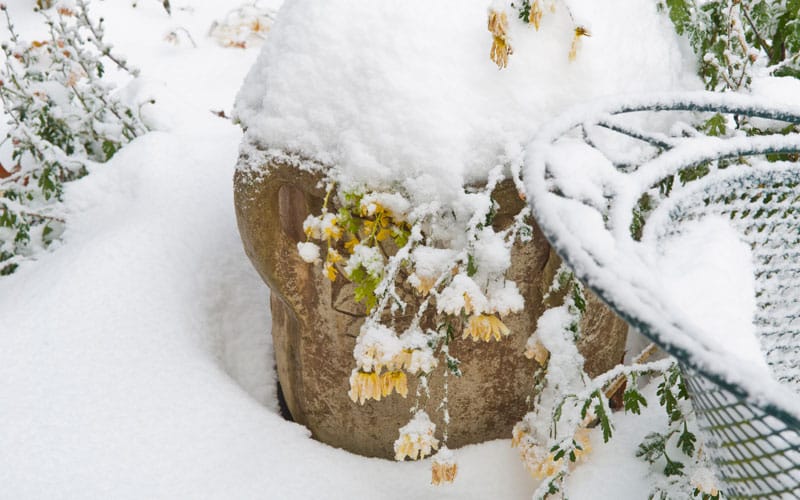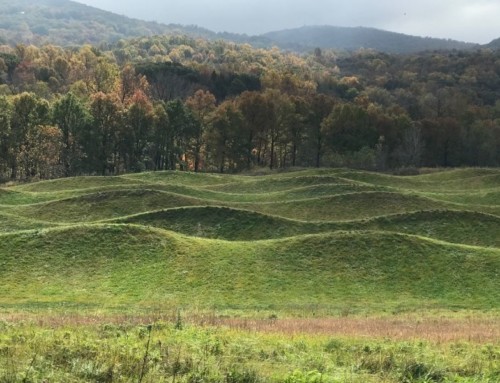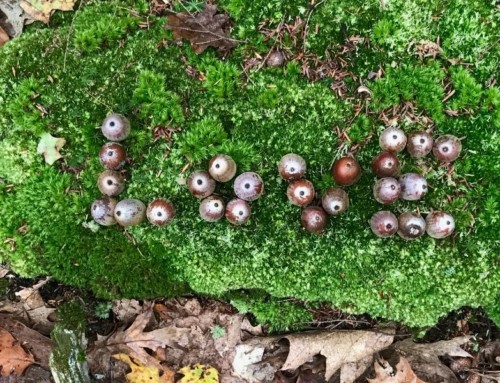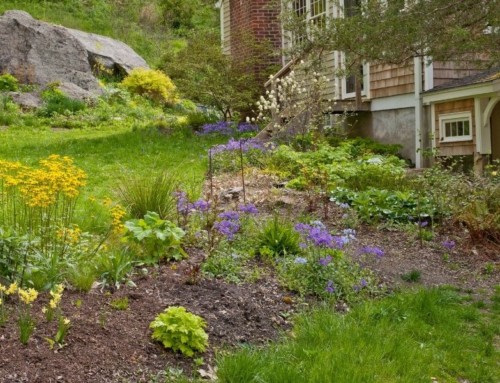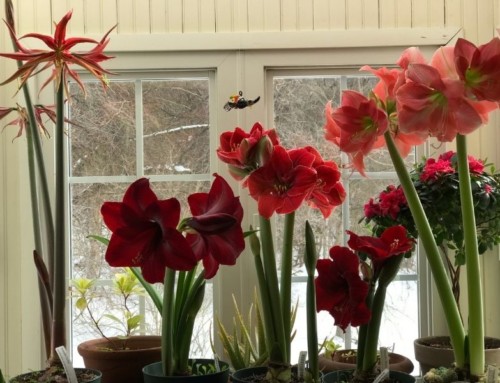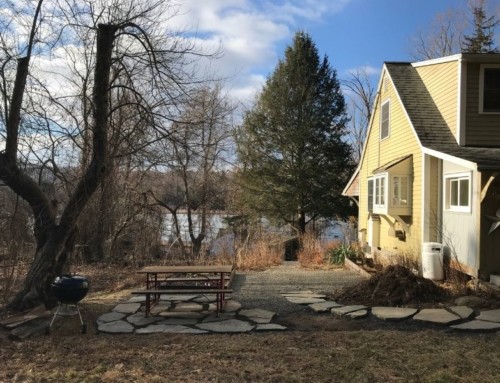The quick change from peak fall foliage to a yard full of grey sticks requires a good bit of attitude adjustment. Southbound robins just stripped my winterberry shrubs bare and deer smashed the chokeberry (Aronia arbutifolia ‘Brilliantissima’) outside my office – so much for cheerful red berries this winter. An early snowstorm put the damper on autumn color (magnolias and flowering dogwoods were dazzling this year) and flattened still-green maidenhair ferns.
Just outside my windows – beauty, heartbreak (deer and vole depredations) and more “to-do’s” than I know what to do with, but also lots of good-looking perennial foliage, dried seedheads jumping with juncos, and a few late-blooming flowers. And hooray for the oaks, #1 wildlife tree, with russet and brown leaves that rustle in the wind when all else is silent.
It’s quiet with windows shut, but with screens off, sunlight floods most agreeably through the house. Leaf-fall reveals the land beyond the bushes. It’s good to have a longer view again. I see that the wood duck who declined the arboreal nesting site on my back slope had good judgment – the tree fell while I wasn’t looking. When it crashed, a cache of catfood kibbles dribbled out – lucky squirrel to find a home near the cat’s dish on my neighbor’s porch.
Late Blooms For Pollinators
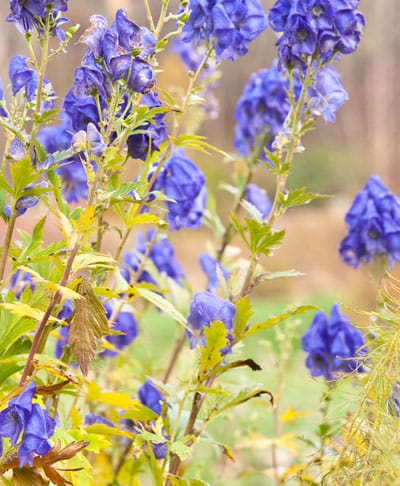
Monkshood
As I keep challenging myself to plant quality food for pollinators, the sight of flowers nourishes me too. The more I learn about interrelationships between plants, insects, animals and birds, the more I’m moved to cultivate biodiversity, to keep asking, “Who is this plant feeding?” and to provide food and habitat year-round.
So many insects evolved to only use native plants for larval food, nectar, pollen, nesting and overwintering sites. Generalists can utilize any number of plants, even some non-natives. But specialists are only able to feed on particular plants or plant families. Eleven bee species, for instance, specialize on goldenrods (Solidago spp.), others on asters.
Fall and early spring are critical times in bees’ life cycle. European honeybees from the farm a mile up the road make a beeline to my snow crocus and snowdrops during January thaws. Ground-nesting native bees emerging in March are sustained by native pussy willow pollen and nectar. September and early October are full of flowers, with asters (now classified as Symphotrichum), sunflowers and goldenrods among the best of the best pollinator plants. But once we hit November, things get iffy. The latest natives I know:
- Fanny’s aster (Symphotrichum oblongifolius ‘Fanny’
- Raydon’s Favorite aster (Symphotrichum oblongifolius ‘Raydon’s Favorite’)
- Smooth aster (Symphotrichum laevis)
- Calico aster (Symphotrichum lateriflorum ‘Lady in Black’)
- Hyssop-leaf thoroughwort (Eupatorium hyssopifolium
- Swamp sunflower (Helianthus angustifolius, H. angustifolius ‘First Light’
With climate change, many bees are still active and looking for food after the latest native plants have gone to seed. Industrious bumblebees, probably our most efficient pollinators, can fly at cooler temperatures than other species. What are these bees and other pollinating insects supposed to eat when the food sources they co-evolved with are out of sync with the seasons? I’ve seen lots of bees buzzing around non-natives that can take cold weather.
- Sweet alyssum
- Monkshood (Aconitum)
- Allium thunbergii
- Chrysanthemums (now Dendranthema)
Keeping Mum(s)
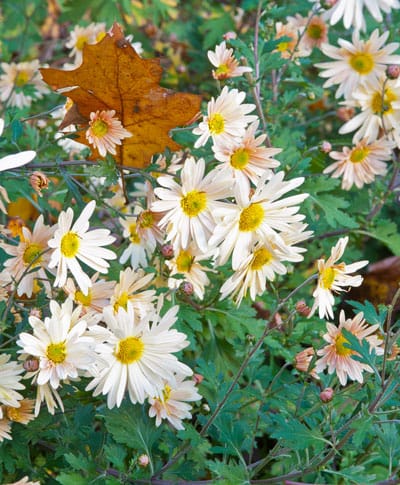
Dendranthema ‘Autumn Moon’
I will forever thank Nancy DuBrule-Clemente of Natureworks in Northford, CT for introducing me to Dendranthema ‘Autumn Moon’, a super-hardy chrysanthemum that takes the prize for late bloom, subtle beauty, attractive foliage and rambunctious vigor. It’s one of the Global Warming Mums ™, an unfortunately no longer marketed series bred to “provide much needed food for bees and beneficial insects still looking for something to eat due to warmer extended fall seasons.”
After 5 years, I still can’t tell you what color they are. Buds are rust-hued, but the flower description – “pale yellow with a hint of pink” – doesn’t do justice to modulating shades of soft coral, ginger, ivory, a faint yellow and finally soft pink fading to white.
Crawling with bees in late October, ‘Autumn Moon’ keeps going longer than the bees do. Snow and temperatures in the 20’s might mess up fully open flowers, but buds keep opening up and down the stems until temperatures hit the teens, usually well past Thanksgiving in my northwest Connecticut garden.
There’s always plenty to pick for bouquets. I like to combine them with stems of northern sea oats (Chasmanthium latifolium), whose graceful nodding seedheads I try to harvest before they sow themselves all over the place. This combo lasts so long in a vase that they probably need dusting before they give up the ghost.
Nancy has made her mission to rescue, collect, propagate (organically) and sell truly hardy garden mums. Don’t confuse them with the primped and prissy mass-produced mums you see everywhere every fall. Those divas rarely make it through the winter and are too stiff-looking to make good garden plants anyway. Plus I suspect that anything so perfect-looking has been sprayed with fungicides or treated with systemic pesticides, both of which are harmful to bees.
For late-fall bees and garden beauty, next year ask your garden center to stock hardy heirloom and Korean mums, or stop by Natureworks for bee-safe plants if you’re in the area. These varieties were still going strong in Nancy’s own garden the third week of November
- ‘Bronze Elegance’
- ‘Mei-kyo’
- ‘Emperor of China’
- Seed-grown Korean mums (Dendranthema koreanum)
And if you’re lucky enough to find any Global Warming Mums, snap them up, make them part of your perennial plantings and be sure to share them with friends. Look for
- ‘Autumn Moon’
- ‘Pink Dawn’
- ‘Purple Mist’
- ‘Glowing Ember’
- ‘Rustic Glow’
A Positive Environmental Outlook
I’m pretty optimistic – most gardeners generally are. As an eco-friendly garden coach, speaker, teacher and writer, I’m committed to effecting positive environmental change, one yard at a time. Collectively, gardeners are stewards for a substantial amount of land; we can make a big difference. But news on the environmental front gets pretty discouraging at times, so I was really glad to hear conservation scientist Dr. Joshua Ginsberg, director of The Cary Institute for Ecosystem Studies in Millbrook, NY speak at The Salisbury Forum on Why I’m an Environmental Optimist. You can check out his inspiring talk below.
https://youtube.com/watch?v=2Pv5TmFM64Y%5B
